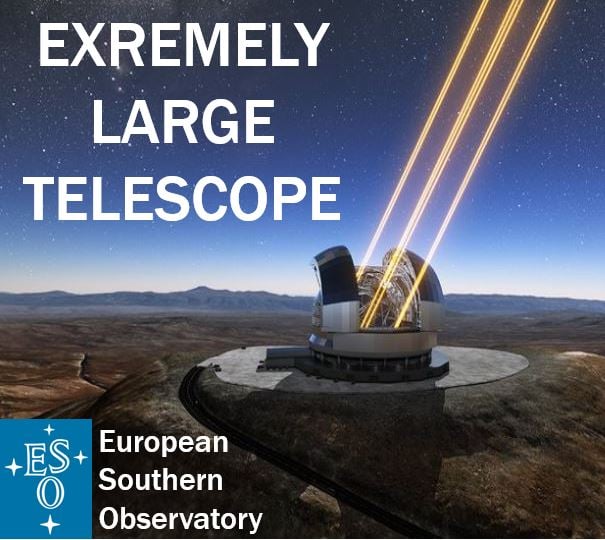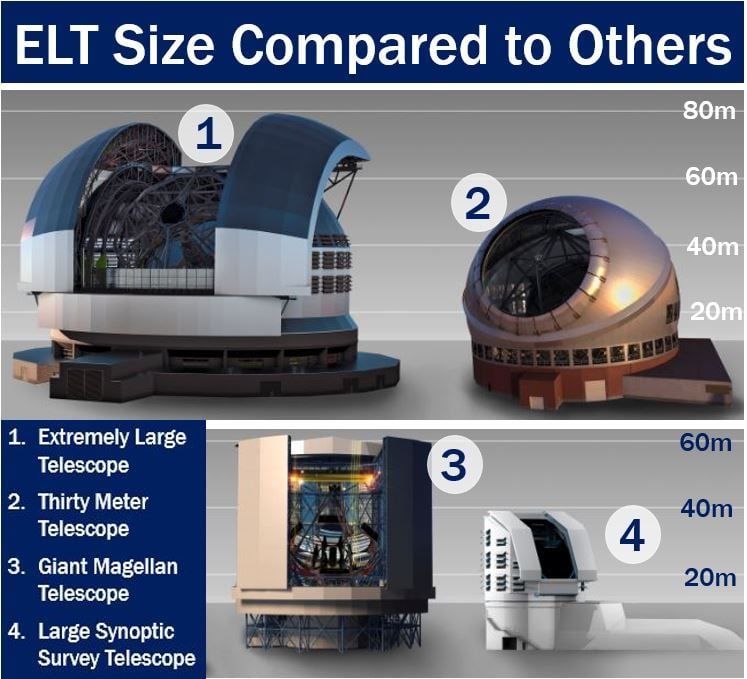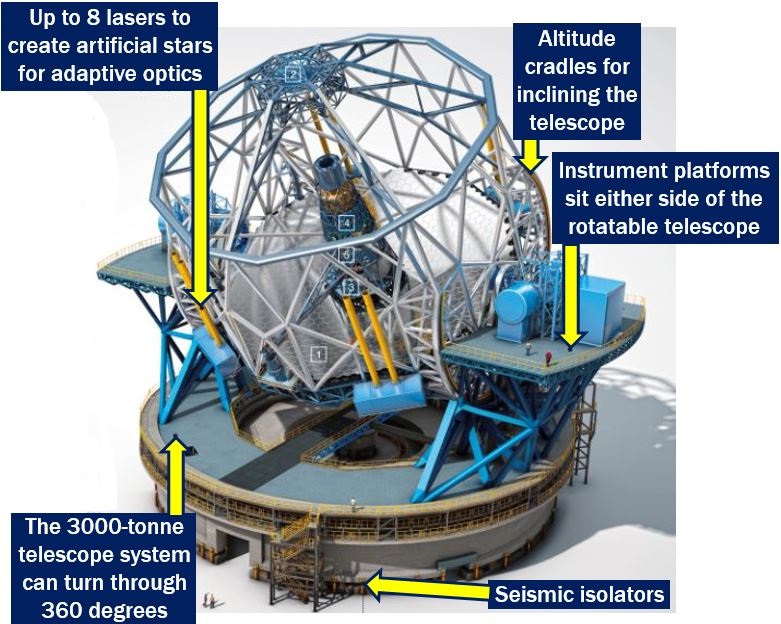The world’s largest optical/infrared telescope – the European Southern Observatory’s Extremely Large Telescope (ELT) – is being built in the Chilean desert. Construction on the giant telescope, which will be about five times bigger than the biggest optical telescope in the world today, started on Friday.
Astronomers say that when completed, the new ELT has the potential to completely transform our current understanding of the Universe. Its backers, including its principal mirrors, will measure approximately 43 yards (39 meters) across.
The device will be housed in a huge rotating dome 85 meters in diameter – comparable to the area of a football (soccer) pitch.
 An artist’s impression of the Extremely Large Telescope in operation in northern Chile at Cerro Amazones. In this illustration, ELT is shown using lasers to create artificial stars high in the atmosphere. (Image: adapted from eso.org)
An artist’s impression of the Extremely Large Telescope in operation in northern Chile at Cerro Amazones. In this illustration, ELT is shown using lasers to create artificial stars high in the atmosphere. (Image: adapted from eso.org)
Telescope on a mountain in the desert
Located in the world’s driest desert – the Atacama – on a 3,000 meter-high mountain, the ELT should be operational in 2024.
On Friday, 26th May, the President of Chile, Michelle Bachelet Jeria, was received by Director General of ESO (European Southern Observatory), Tim de Zeeuw, as well as other scientists and lawmakers at the ceremony, marking the first stone of ESO’s ELT.
The event was held at the Paranal Observatory, an ESO site, which is very near to the site where the world’s largest optical/infrared telescope is being built.
During the ceremony, a time capsule, which had been prepared by ESO, was sealed. The capsule contains a copy of the book which describes the future scientific goals of ELT, as well as a poster of photographs of all current ESO personnel.
 This graphic of the dome shows how much larger the Extremely Large Telescope (ELT) is compared to other ground-based facilities that currently are under construction. (Image: adapted from eso.org)
This graphic of the dome shows how much larger the Extremely Large Telescope (ELT) is compared to other ground-based facilities that currently are under construction. (Image: adapted from eso.org)
The time capsule’s cover is an engraved hexagon made of Zeodur®, a 1/5 scale model of one of the ELT’s primary mirror segments.
President Bachelet said:
“With the symbolic start of this construction work, we are building more than a telescope here: it is one of the greatest expressions of scientific and technological capabilities and of the extraordinary potential of international cooperation.”
ELT being built by ACe Consortion
In 2016, ESO signed a contract with the ACe Consortium – consisting of Cimolai, Astaldi, and EIE Group (subcontractor) – for the construction of the telescope structure (eso1617) and the dome. The laying of the first stone on Friday marked the beginning of the whole construction project.
“The ELT will be the biggest “eye” ever pointed towards the sky and may revolutionise our perception of the Universe. It will tackle a wide range of scientific challenges, including probing Earth-like exoplanets for signs of life, studying the nature of dark energy and dark matter, and observing the Universe’s early stages to explore our origins.”
“It will also raise new questions we cannot conceive of today, as well as improving life here on Earth through new technology and engineering breakthroughs.”
 This illustration provides a basic breakdown of the Extremely Large Telescope’s structure, focusing particularly on its first-generation instruments. It is expected to see first light in 2024, and the instruments a year later. (Image: adapted from eso.org)
This illustration provides a basic breakdown of the Extremely Large Telescope’s structure, focusing particularly on its first-generation instruments. It is expected to see first light in 2024, and the instruments a year later. (Image: adapted from eso.org)
The Extremely Large Telescope
The ELT is considered globally as one of the top priorities in ground-based astronomy, says ESO. ELTs will significantly advance astrophysical knowledge, allowing detailed studies of the first objects in the Universe, planets in other star systems, super-massive black holes, and the nature and distribution of the dark energy and dark matter which dominate the Universe.
ESO has been working with industry and its community to develop an extremely large optical/infrared telescope. This revolutionary, new ground-based telescope concept will be the “world’s biggest eye in the sky.”
The European Southern Observatory writes:
“The ELT will tackle the biggest scientific challenges of our time, and aim for a number of notable firsts, including tracking down Earth-like planets around other stars in the ‘habitable zones’ where life could exist — one of the Holy Grails of modern observational astronomy.”
“It will also perform “stellar archaeology” in nearby galaxies, as well as make fundamental contributions to cosmology by measuring the properties of the first stars and galaxies and probing the nature of dark matter and dark energy.”
“On top of this astronomers are also planning for the unexpected — new and unforeseeable questions will surely arise from the new discoveries made with the ELT.”
An #ELT trailer to leave you in anticipation of the #BiggestEyeOnTheSky. Thanks for following us! https://t.co/7B5AaUW2oO pic.twitter.com/TN3cMclUUu
— ESO (@ESO) May 26, 2017
Are we alone?
Astronomers hope that the Extremely Large Telescope will help answer one of humankind’s oldest questions: “Are we alone in the Universe?”
ESO says that the ELT has embraced the quest for planets outside our Solar System. This will include not only searching for and studying Earth-like masses through indirect measurements of the wobbling motion of parent stars by the planets and other celestial bodies that orbit them, but also the direct imaging of bigger planets, and perhaps even the characterization of their atmospheres.
The telescope’s suite of instruments will allow scientists to probe the initial stages of the formation of planetary systemsm and to detect organic molecules and water in protoplanetary discs around stars in the making.
In its article – ‘Are We Alone’ – ESO writes:
“Thus, the ELT will answer fundamental questions regarding planet formation and evolution and will bring us one step closer to answering the question: are we alone? Apart from the obvious scientific interest, this would represent a major breakthrough for humanity.”
The European Southern Observatory, created in 1962, is the foremost intergovernmental astronomy organization in Europe. It claims to be the most productive astronomical observatory in the world.
On its ‘about us’ page, the European Southern Observatory writes:
“ESO provides state-of-the-art research facilities to astronomers and is supported by Austria, Belgium, Brazil, the Czech Republic, Denmark, Finland, France, Germany, Italy, the Netherlands, Poland, Portugal, Spain, Sweden, Switzerland and the United Kingdom, along with the host state of Chile. Several other countries have expressed an interest in membership.”
Video – Extremely Large Telescope first stone ceremony
This European Southern Observatory video is of the first stone ceremony for ESO’s Extremely Large Telescope that was held at the Paranal Observatory in northern Chile, in presence of the country’s President.
